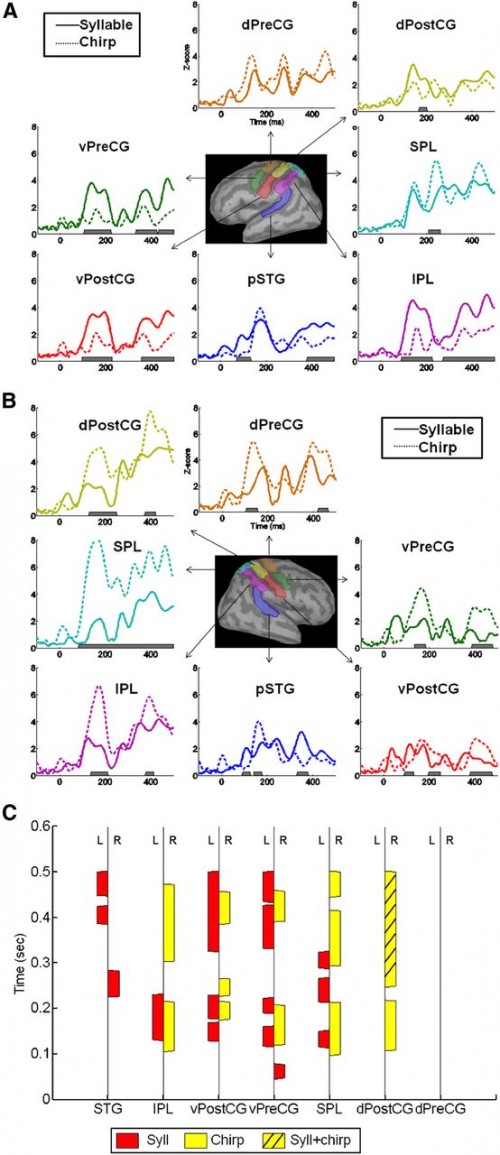The capacity to think and communicate with the specificity and nuance enabled by language is arguably the most important distinction of humans from other sEEGpecies. Neural circuits underlying semantic processing are widely distributed in the brain, and mostly left lateralized (reviewed in 1). Language is used to convey emotions, but the neural dynamics and neural interactions underlying word valence perception are not well understood (reviewed in 2). We use multimodal neuroimaging methods with high spatial (fMRI) and high temporal (EEG) resolution to resolve the spatiotemporal patterns of activation of language and emotional neural circuits. Multimodal neuroimaging is essential for resolving bottom-up and top-down influences on perceptual processes (for example, in speech perception, in 3).
One of the advantages of examining emotional dysfunction through the lens of linguistic processing is that finer distinctions between different types of emotions can be made with words compared to other types of experimental stimuli such as images. Different experimental word lists can be constructed to tap into, for example, trauma-related anxiety (e.g. for sexual trauma, rape, assault, force) and panic-related anxiety (e.g. scared, accident, cancer). Our group has demonstrated that affectively-valenced words elicit different responses in frontal, limbic and language brain areas, in subjects suffering from emotional disorders compared to normal controls (4-6).
Language is thought to play a major modulatory role in emotion perception. Interventions targeting linguistic processing are therefore promising for the regulation of emotions (7). We are testing semantic associative training as a model for how the perception of emotional words can be shifted, from a mode rooted in episodic or autobiographic memory, to a mode rooted in conceptual knowledge abstracted from one’s own life experiences. If successful, this approach would provide one of the first cognitive neuroscience frameworks for understanding the neural basis of psychotherapy for emotional disorders.

Liebenthal E, Silbersweig D, Stern E. The language, tone and prosody of emotions: Neural dynamics of spoken-word valence perception. Neurosci. doi: 10.3389/fnins.2016.00506 (in press).
Liebenthal E, Desai RH, Humphries C, Sabri M, Desai A (2014). The functional organization of the left STS: a large scale meta-analysis of PET and fMRI studies of healthy adults. Frontiers in Neuroscience, 8:289. doi: 10.3389/fnins.2014.00289. PMCID: PMC4160993
Liebenthal E, Silbersweig DA, Stern E. The language of emotions: Neural Dynamics of spoken word valence perception (submitted).
Liebenthal E, Sabri M, Beardsley S, Mangalathu-Arumana J, Desai A (2013). Neural dynamics of phonological processing in the dorsal auditory stream. Neuroscience, 33(39):15414-24. doi: 10.1523/JNEUROSCI.1511-13.2013. PMCID: PMC3782621
Isenberg N, Silbersweig D, Engelien A, Emmerich S, Malavade K, Beattie B, Leon AC, Stern E. Linguistic threat activates the human amygdala. Proceedings of the National Academy of Sciences of the United States of America. 1999;96(18):10456-9. Epub 1999/09/01. PubMed PMID: 10468630; PubMed Central PMCID: PMC17910.
Protopopescu X, Pan H, Tuescher O, Cloitre M, Goldstein M, Engelien W, Epstein J, Yang Y, Gorman J, LeDoux J, Silbersweig D, Stern E. Differential time courses and specificity of amygdala activity in posttraumatic stress disorder subjects and normal control subjects. Biological psychiatry. 2005;57(5):464-73. Epub 2005/03/02. doi: S0006-3223(04)01366-6 [pii] 1016/j.biopsych.2004.12.026. PubMed PMID: 15737660.
Weisholtz DS, Root JC, Butler T, Tüscher O, Epstein J, Pan H, Protopopescu X, Goldstein M, Isenberg N, Brendel G, LeDoux J, Silbersweig DA, Stern E. Beyond the amygdala: Linguistic threat modulates perisylvian semantic access cortices. Brain Lang. 2015 Dec;151:12-22. doi: 10.1016/j.bandl.2015.10.004. Epub 2015 Nov 11.
Beutel ME, Stern E, Silbersweig DA. The emerging dialogue between psychoanalysis and neuroscience: neuroimaging perspectives. J Am Psychoanal Assoc. 2003;51(3):773-801. Epub 2003/11/05. PubMed PMID: 14596561.
